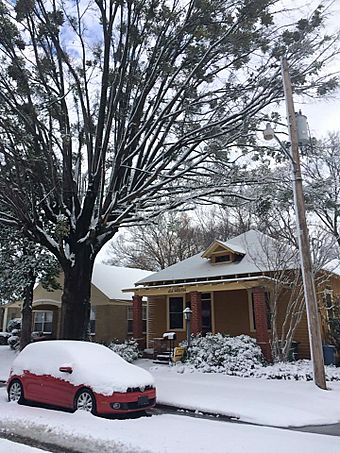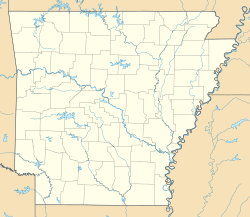Argenta Historic District facts for kids
|
Argenta Historic District
|
|
 |
|
| Location | Roughly, Melrose Cir. and Willow St. S to W. 4th St., and Main St. from W. 6th St. to W. 3rd St. (original); 616 Orange St., 116 W. 7th St., 206 W. 7th St., 212 W. 7th St., 220 W. 7th St., 616 Maple St., and 620 Maple St. (first increase); Roughly bounded by N. Poplar, 9th St., N. Broadway, W. 4th, and Broadway (second increase); North Little Rock, Arkansas. |
|---|---|
| Area | 33 acres (13 ha) |
| Architect | Charles L. Thompson, H. Ray Burks |
| Architectural style | Colonial Revival, Bungalow/Craftsman, Commercial Style, Italianate, Queen Anne |
| NRHP reference No. | 93000094 (original) 02000076 (increase 1) 06001217 (increase 2) |
Quick facts for kids Significant dates |
|
| Added to NRHP | March 15, 1993 |
| Boundary increases | February 22, 2002 March 8, 2007 |
The Argenta Historic District is a special area in central North Little Rock, Arkansas. It's like a time capsule, showing important parts of the city's past. This district helps us remember how North Little Rock grew and changed over many years.
Contents
History of Argenta and North Little Rock
The place we now call central North Little Rock was first known as Argenta. It was settled a long time ago. Argenta stayed its own community until 1890. At that time, it became part of Little Rock.
How North Little Rock Became a City
A local leader named William Faucette wanted Argenta to be its own city again. In 1901, he helped create North Little Rock. This new city was just outside the area that Little Rock had taken over.
Then, in 1903, William Faucette worked hard to separate Argenta from Little Rock. He succeeded, and Argenta joined the new city of North Little Rock. People tried to change North Little Rock's name back to Argenta later, but it didn't happen.
What Makes the District Special?
The Argenta Historic District is made of two separate parts. One part is for businesses, and the other is for homes. This district was first recognized as historically important in 1993. It was added to the National Register of Historic Places.
The Commercial Area
The business part of the district is on Main Street. It covers three blocks, from Broadway Street to 6th Street. Most of these buildings were built between 1900 and 1940. There are 18 buildings here that are very important to history.
Some of these buildings are so special they are listed separately. These include the North Little Rock City Hall, the old Post Office (now the Argenta Branch Library), the Faucette Building, and the Old Central Fire Station.
The Residential Area
The residential part of the district is about three blocks west of the commercial area. It's mainly around Willow Street, from 4th Street to Melrose Circle. It also includes homes on nearby cross streets.
This area has 177 buildings in total. When the district was first created, 77 of these homes were seen as historically important. The Baker House and Barth-Hempfling House are two examples. Many homes that were not first included could be in the future. This is because they might just need some updates to look like they did in the past.
Architectural Styles in Argenta
Many homes in the residential area are built in the Craftsman style. This style often features natural materials and simple designs. You can also find many homes in the Colonial Revival style. These homes often look like older, grander houses from America's past.
Images for kids





